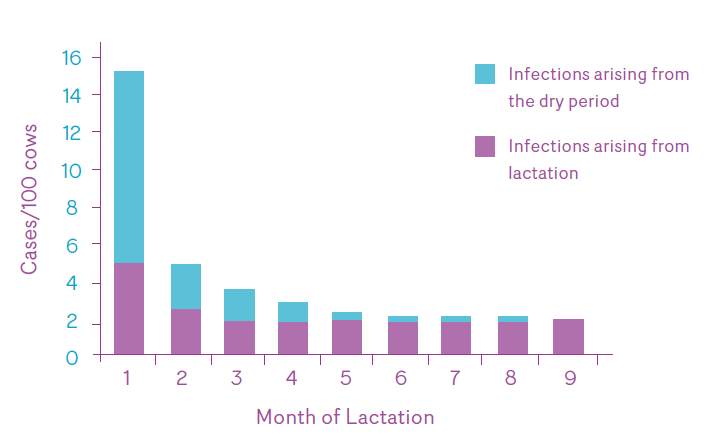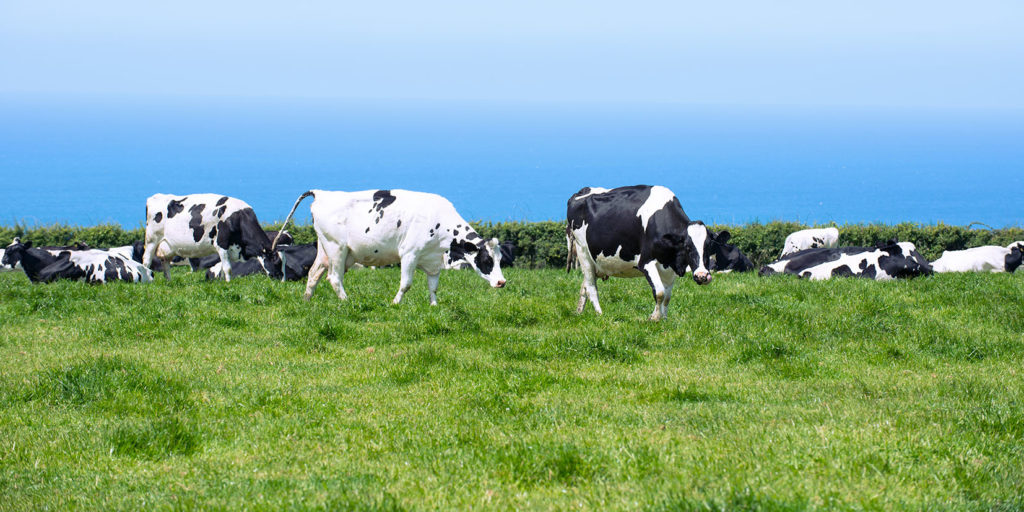Teat Sealants and Mastitis of Dry Period Origin
24 April 2018As there is increasing pressure on dairy farmers to reduce antibiotic usage and practice selective dry cow therapy (SDCT), the use of internal teat sealants is becoming increasingly important to protect udder health and reduce mastitis during the dry period, as well as in early lactation. Surprisingly there are still farms which practice SDCT and do not use a teat sealant, and their use is crucial to reduce intramammary infections picked up during the dry period.
Whilst it is well known that mastitis cases in the first 30 days after calving have a high probability of being caused by an infection picked up during the dry period, mastitis later in lactation may still be a result of a dry period infection. Green et al (2002) reported that in some herds over 60% of all clinical mastitis during lactation can be traced to bacterial infections that occurred in the dry period (see graph below). Also the risk of picking up new infections is 10 times greater during the dry period than throughout lactation.
The origin of infection (dry period or lactation) in clinical mastitis cases

Source: Green, M.J., Green, L.E., Medley, G.F., Shukken, Y.H., Bradley, A.J. Influence of dry period bacterial intrammammary infection on clinical mastitis in dairy cows. J. Dairy Sci. 2002;85(10): 2589-99
Antibiotics are very effective at curing infections during the early part of the dry period. However, infections are more likely to arise late in the dry period when the protective effect of antibiotics has worn off and teat ends are more likely to be open, with the natural keratin plug breaking down and lactoferrin levels within the udder dropping. Lactoferrin is a natural protective factor found in high concentrations in dry cow secretions which inhibits growth of mastitis-causing pathogens. During the late dry period, the risk is greatest from environmental bacteria such as E.coli and S. uberis.
Bacterial numbers on the teat skin increase significantly after drying off, as milking hygiene practices cease. At calving, bacterial numbers can increase even more due to leaking colostrum which encourages growth of bacteria. Cleanliness of dry cow housing and bedding management are critical to reducing the infection risk. For dry cows that are at grass, it is recommended to graze the land for 2 weeks and then leave it ungrazed for 4 weeks before regrazing. This has been shown to lower the rate of clinical mastitis.
Internal teat sealants are proven to reduce clinical mastitis in the following lactation by 25 to 30%. They are also proven to be just as effective in preventing new intramammary infections compared to using both teat sealant and antibiotic dry cow therapy in cows with a low cell count before drying off. Their effectiveness is greatest in the modern, high yielding dairy cow, where the naturally produced keratin plug is often inadequately produced and fails to properly seal teat ends. Typically, 50% of teat ends remain open 1 week after drying off and 5% of teat ends never close (Williamson et al 1995).
Risk of infection during the dry period increases with increasing parity, higher milk yield at drying off and teat end damage. Even over-conditioned cows are thought to be more at risk and cows that leak milk after drying off are 4 times more likely to have a case of clinical mastitis than cows that do not leak milk.
Therefore, higher yielding and older cows are more likely to benefit from the protective effects of an internal teat sealant and this should be a must when practicing SDCT. It goes without saying that strict hygiene practices at drying off are crucial, especially when using teat sealants alone, as severe mastitis can result if infection is introduced with the sealant. However, many farms are now practising SDCT successfully and drying off cows with just teat sealant alone, with no detrimental effect on the dry period performance (in terms of individual somatic cell counts pre-drying off and post-calving) or clinical mastitis rates.
Reference: Williamson , J.H., Woolford, M.W., Day, A.M. The prophylactic effect of a dry-cow antibiotic against Streptococcus uberis. N Z Vet J 1995;43:228–34.
lorna.macpherson@sac.co.uk; Dairy Consultant
Sign up to the FAS newsletter
Receive updates on news, events and publications from Scotland’s Farm Advisory Service

